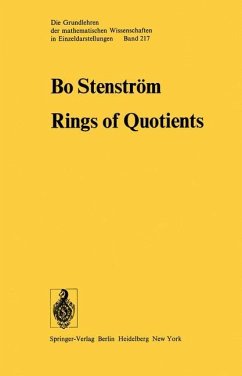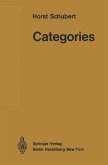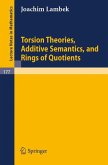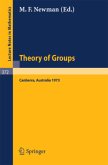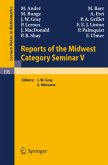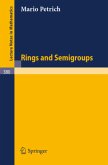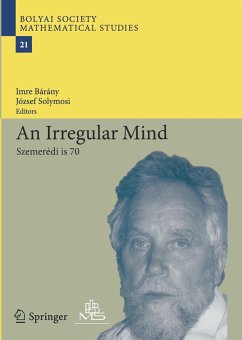- Broschiertes Buch
- Merkliste
- Auf die Merkliste
- Bewerten Bewerten
- Teilen
- Produkt teilen
- Produkterinnerung
- Produkterinnerung
The theory of rings of quotients has its origin in the work of (j). Ore and K. Asano on the construction of the total ring of fractions, in the 1930's and 40's. But the subject did not really develop until the end of the 1950's, when a number of important papers appeared (by R. E. Johnson, Y. Utumi, A. W. Goldie, P. Gabriel, J. Lambek, and others). Since then the progress has been rapid, and the subject has by now attained a stage of maturity, where it is possible to make a systematic account of it (which is the purpose of this book). The most immediate example of a ring of quotients is the…mehr
Andere Kunden interessierten sich auch für
![Categories Categories]() Horst SchubertCategories39,99 €
Horst SchubertCategories39,99 €![Torsion Theories, Additive Semantics, and Rings of Quotients Torsion Theories, Additive Semantics, and Rings of Quotients]() Joachim LambekTorsion Theories, Additive Semantics, and Rings of Quotients20,99 €
Joachim LambekTorsion Theories, Additive Semantics, and Rings of Quotients20,99 €![Proceedings of the Second International Conference on the Theory of Groups Proceedings of the Second International Conference on the Theory of Groups]() Proceedings of the Second International Conference on the Theory of Groups36,99 €
Proceedings of the Second International Conference on the Theory of Groups36,99 €![Reports of the Midwest Category Seminar V Reports of the Midwest Category Seminar V]() Reports of the Midwest Category Seminar V27,99 €
Reports of the Midwest Category Seminar V27,99 €![The Development of the Number Field Sieve The Development of the Number Field Sieve]() LenstraThe Development of the Number Field Sieve31,99 €
LenstraThe Development of the Number Field Sieve31,99 €![Rings and Semigroups Rings and Semigroups]() M. PetrichRings and Semigroups20,99 €
M. PetrichRings and Semigroups20,99 €![An Irregular Mind An Irregular Mind]() An Irregular Mind111,99 €
An Irregular Mind111,99 €-
-
-
The theory of rings of quotients has its origin in the work of (j). Ore and K. Asano on the construction of the total ring of fractions, in the 1930's and 40's. But the subject did not really develop until the end of the 1950's, when a number of important papers appeared (by R. E. Johnson, Y. Utumi, A. W. Goldie, P. Gabriel, J. Lambek, and others). Since then the progress has been rapid, and the subject has by now attained a stage of maturity, where it is possible to make a systematic account of it (which is the purpose of this book). The most immediate example of a ring of quotients is the field of fractions Q of a commutative integral domain A. It may be characterized by the two properties: (i) For every qEQ there exists a non-zero SEA such that qSEA. (ii) Q is the maximal over-ring of A satisfying condition (i). The well-known construction of Q can be immediately extended to the case when A is an arbitrary commutative ring and S is a multiplicatively closed set of non-zero-divisors of A. In that case one defines the ring of fractions Q = A [S-l] as consisting of pairs (a, s) with aEA and SES, with the declaration that (a, s)=(b, t) if there exists UES such that uta = usb. The resulting ring Q satisfies (i), with the extra requirement that SES, and (ii).
Produktdetails
- Produktdetails
- Grundlehren der mathematischen Wissenschaften 217
- Verlag: Springer / Springer Berlin Heidelberg / Springer, Berlin
- Artikelnr. des Verlages: 978-3-642-66068-9
- Softcover reprint of the original 1st ed. 1975
- Seitenzahl: 324
- Erscheinungstermin: 22. Dezember 2011
- Englisch
- Abmessung: 244mm x 170mm x 18mm
- Gewicht: 560g
- ISBN-13: 9783642660689
- ISBN-10: 3642660681
- Artikelnr.: 36119557
- Grundlehren der mathematischen Wissenschaften 217
- Verlag: Springer / Springer Berlin Heidelberg / Springer, Berlin
- Artikelnr. des Verlages: 978-3-642-66068-9
- Softcover reprint of the original 1st ed. 1975
- Seitenzahl: 324
- Erscheinungstermin: 22. Dezember 2011
- Englisch
- Abmessung: 244mm x 170mm x 18mm
- Gewicht: 560g
- ISBN-13: 9783642660689
- ISBN-10: 3642660681
- Artikelnr.: 36119557
Notations and Conventions.- I. Modules.- 1. Basic Definitions.- 2. Sums and Products of Modules.- 3. Finitely Generated Modules and Noetherian Modules.- 4. Categories and Functors.- 5. Exactness of Functors between Module Categories.- 6. Projective and Injective Modules.- 7. Semi-Simple Modules and Rings.- 8. Tensor Products.- 9. Bimodules.- 10. Flat Modules.- 11. Pure Submodules.- 12. Regular Rings.- 13. Coherent Rings.- Exercises.- II. Rings of Fractions.- 1. The Ring of Fractions.- 2. Orders in a Semi-Simple Ring.- 3. Modules of Fractions.- 4. Invertible Ideals and Hereditary Orders.- Exercises.- III. Modular Lattices.- 1. Lattices.- 2. Modularity.- 3. Lattices with Chain Condition.- 4. Distributive Lattices.- 5. Continuous Lattices.- 6. Pseudo-Complemented Lattices.- 7. Closure Operators.- 8. Galois Connections.- Exercises.- IV. Abelian Categories.- 1. Equivalence of Categories.- 2. Kernels and Cokernels.- 3. Products and Coproducts.- 4. Abelian Categories.- 5. Pullbacks and Pushouts.- 6. Generators and Cogenerators.- 7. Functor Categories.- 8. Limits and Colimits.- 9. Adjoint Functors.- 10. Morita Equivalence.- Exercises.- V. Grothendieck Categories.- 1. Exactness of Direct Limits.- 2. Injective Envelopes.- 3. Finitely Generated Objects.- 4. Locally Noetherian Categories.- 5. The Krull-Remak-Schmidt-Azumaya Theorem.- 6. Spectral Categories.- 7. The Spectral Category of a Grothendieck Category.- Exercises.- VI. Torsion Theory.- 1. Preradicals.- 2. Torsion Theories.- 3. Hereditary Torsion Theories.- 4. Linear Topologies.- 5. Gabriel Topologies.- 6. Examples of Gabriel Topologies.- 7. Stable Torsion.- 8. TTF-Classes.- 9. ?-Divisible Modules.- Exercises.- VII. Hereditary Torsion Theories for Noetherian Rings.- 1. Associated Prime Ideals.- 2. Fully Bounded Noetherian Rings.- 3. Topologies for a Fully Bounded Noetherian Ring.- 4. Artin-Rees Modules and Stable Topologies.- 5. Auxiliary Results on Commutative Localization.- 6. The Topologies ?Mn for a Commutative Noetherian Ring.- Exercises.- VIII. Simple Torsion Theories.- 1. The Jacobson Radical and Artinian Rings.- 2. Semi-Artinian Modules and Rings.- 3. Simple Torsion Theories.- 4. Semi-Perfect Rings.- 5. Perfect Rings.- 6. Hereditary Torsion Theories for a Perfect Ring.- Exercises.- IX. Rings and Modules of Quotients.- 1. Construction of Modules of Quotients.- 2. ?-Injective Envelopes.- 3. The Ring of Quotients is a Bicommutator.- 4. The Lattice of Saturated Submodules.- 5. ?-Invertible Ideals.- Exercises.- X. The Category of Modules of Quotients.- 1. Giraud Subcategories.- 2. Gabriel Topologies and Giraud Subcategories.- 3. Rings of Quotients of Morita Equivalent Rings.- 4. Representation of Grothendieck Categories.- Exercises.- XI. Perfect Localizations.- 1. Epimorphisms of Rings.- 2. Flat Epimorphisms of Rings.- 3. Perfect Gabriel Topologies.- 4. The Maximal Flat Epimorphic Ring of Quotients.- 5. The Maximal Ring of Quotients as a Perfect Localization.- 6. 1-Topologies and Rings of Fractions.- 7. Finite Localizations.- 8. The Endomorphism Ring of a Finitely Generated Projective Module.- Exercises.- XII. The Maximal Ring of Quotients of a Non-Singular Ring.- 1. Standard Representation of Spectral Categories.- 2. The Maximal Ring of Quotients.- 3. The Maximal Ring of Quotients of a Boolean Ring.- 4. The Lattice of EssentiallyClosed Ideals.- 5. The Maximal Ring of Quotients of a Reduced Ring.- 6. Flatness of the Maximal Ring of Quotients.- 7. Imbedding Non-Singular Modules in Free Modules.- Exercises.- XIII. Finiteness Conditions on Mod-(A, ?).- 1. Compact Lattices of Saturated Submodules.- 2. ?-Noetherian Rings.- 3. The Goldie Topology.- 4. P-Noetherian Rings.- 5. The Canonical Topology of a Krull Domain.- Exercises.- XIV. Self-Injective Rings.- 1. The Endomorphism Ring of an Injective Module.- 2. Self-Injective Rings and Annihilator Conditions.- 3. Quasi-Frobenius Rings.- 4. Self-Injective Maximal Rings of Quotients.- Exercises.- XV. Classical Rings of Quotients.- 1. Semi-Prime Ideals and the Prime Radical.- 2. Rings of Quotients of Quotient Rings.- 3. Orders in a Semi-Primary Ring.- 4. Noetherian Orders in an Artinian Ring.- 5. Orders in Self-Injective Rings.- 6. Rings of Quotients of Group Algebras.- Exercises.
Notations and Conventions.- I. Modules.- 1. Basic Definitions.- 2. Sums and Products of Modules.- 3. Finitely Generated Modules and Noetherian Modules.- 4. Categories and Functors.- 5. Exactness of Functors between Module Categories.- 6. Projective and Injective Modules.- 7. Semi-Simple Modules and Rings.- 8. Tensor Products.- 9. Bimodules.- 10. Flat Modules.- 11. Pure Submodules.- 12. Regular Rings.- 13. Coherent Rings.- Exercises.- II. Rings of Fractions.- 1. The Ring of Fractions.- 2. Orders in a Semi-Simple Ring.- 3. Modules of Fractions.- 4. Invertible Ideals and Hereditary Orders.- Exercises.- III. Modular Lattices.- 1. Lattices.- 2. Modularity.- 3. Lattices with Chain Condition.- 4. Distributive Lattices.- 5. Continuous Lattices.- 6. Pseudo-Complemented Lattices.- 7. Closure Operators.- 8. Galois Connections.- Exercises.- IV. Abelian Categories.- 1. Equivalence of Categories.- 2. Kernels and Cokernels.- 3. Products and Coproducts.- 4. Abelian Categories.- 5. Pullbacks and Pushouts.- 6. Generators and Cogenerators.- 7. Functor Categories.- 8. Limits and Colimits.- 9. Adjoint Functors.- 10. Morita Equivalence.- Exercises.- V. Grothendieck Categories.- 1. Exactness of Direct Limits.- 2. Injective Envelopes.- 3. Finitely Generated Objects.- 4. Locally Noetherian Categories.- 5. The Krull-Remak-Schmidt-Azumaya Theorem.- 6. Spectral Categories.- 7. The Spectral Category of a Grothendieck Category.- Exercises.- VI. Torsion Theory.- 1. Preradicals.- 2. Torsion Theories.- 3. Hereditary Torsion Theories.- 4. Linear Topologies.- 5. Gabriel Topologies.- 6. Examples of Gabriel Topologies.- 7. Stable Torsion.- 8. TTF-Classes.- 9. ?-Divisible Modules.- Exercises.- VII. Hereditary Torsion Theories for Noetherian Rings.- 1. Associated Prime Ideals.- 2. Fully Bounded Noetherian Rings.- 3. Topologies for a Fully Bounded Noetherian Ring.- 4. Artin-Rees Modules and Stable Topologies.- 5. Auxiliary Results on Commutative Localization.- 6. The Topologies ?Mn for a Commutative Noetherian Ring.- Exercises.- VIII. Simple Torsion Theories.- 1. The Jacobson Radical and Artinian Rings.- 2. Semi-Artinian Modules and Rings.- 3. Simple Torsion Theories.- 4. Semi-Perfect Rings.- 5. Perfect Rings.- 6. Hereditary Torsion Theories for a Perfect Ring.- Exercises.- IX. Rings and Modules of Quotients.- 1. Construction of Modules of Quotients.- 2. ?-Injective Envelopes.- 3. The Ring of Quotients is a Bicommutator.- 4. The Lattice of Saturated Submodules.- 5. ?-Invertible Ideals.- Exercises.- X. The Category of Modules of Quotients.- 1. Giraud Subcategories.- 2. Gabriel Topologies and Giraud Subcategories.- 3. Rings of Quotients of Morita Equivalent Rings.- 4. Representation of Grothendieck Categories.- Exercises.- XI. Perfect Localizations.- 1. Epimorphisms of Rings.- 2. Flat Epimorphisms of Rings.- 3. Perfect Gabriel Topologies.- 4. The Maximal Flat Epimorphic Ring of Quotients.- 5. The Maximal Ring of Quotients as a Perfect Localization.- 6. 1-Topologies and Rings of Fractions.- 7. Finite Localizations.- 8. The Endomorphism Ring of a Finitely Generated Projective Module.- Exercises.- XII. The Maximal Ring of Quotients of a Non-Singular Ring.- 1. Standard Representation of Spectral Categories.- 2. The Maximal Ring of Quotients.- 3. The Maximal Ring of Quotients of a Boolean Ring.- 4. The Lattice of EssentiallyClosed Ideals.- 5. The Maximal Ring of Quotients of a Reduced Ring.- 6. Flatness of the Maximal Ring of Quotients.- 7. Imbedding Non-Singular Modules in Free Modules.- Exercises.- XIII. Finiteness Conditions on Mod-(A, ?).- 1. Compact Lattices of Saturated Submodules.- 2. ?-Noetherian Rings.- 3. The Goldie Topology.- 4. P-Noetherian Rings.- 5. The Canonical Topology of a Krull Domain.- Exercises.- XIV. Self-Injective Rings.- 1. The Endomorphism Ring of an Injective Module.- 2. Self-Injective Rings and Annihilator Conditions.- 3. Quasi-Frobenius Rings.- 4. Self-Injective Maximal Rings of Quotients.- Exercises.- XV. Classical Rings of Quotients.- 1. Semi-Prime Ideals and the Prime Radical.- 2. Rings of Quotients of Quotient Rings.- 3. Orders in a Semi-Primary Ring.- 4. Noetherian Orders in an Artinian Ring.- 5. Orders in Self-Injective Rings.- 6. Rings of Quotients of Group Algebras.- Exercises.

